(1)
Department of Pathology, Duke University Medical Center, Durham, NC, USA
Abstract
The eye is a remarkable organ, and vision is one of our greatest gifts. The eye is affected by countless systemic and local processes resulting in a wide range of diagnostic possibilities; indeed, many of the nonophthalmic general and subspecialized surgical pathology diagnoses are just as readily made when they do involve the eye and ocular adnexa.
Ophthalmic pathology is learned in a manner similar to the other specialties in surgical pathology. You study the anatomy and normal histology, look at as many cases as you can, attend daily sign-out, go to conferences (daily lectures; unknown slide conferences; local, national, and international meetings), and read as much as you can. It also helps if you have excellent teachers, mentors, and learning materials to guide you along the way.
This chapter provides a basic and generalized overview of ophthalmic pathology and is followed by chapters highlighting the major pathology of the cornea, conjunctiva, eyelid, uveal tract, retina, orbit, and optic nerve. The vitreous, sclera, and lacrimal drainage system are mentioned briefly.
The eye is a remarkable organ, and vision is one of our greatest gifts. The eye is affected by countless systemic and local processes resulting in a wide range of diagnostic surgical pathology possibilities. This chapter provides a basic and generalized overview of ophthalmic pathology.
What Exactly Does Ophthalmic Pathology Comprise?
The eye (globe):
Cornea
Iris
Ciliary body
Choroid
Retina
Vitreous:
The vitreous is the liquid/gel of the posterior chamber of the eye.
The cellularity is normally low and contains macrophage-like cells called hyalocytes.
Vitreous biopsies are most often examined as cytology preparations, usually when lymphoma or an inflammatory/infectious process is suspected.
Sclera:
The sclera is the white part of the eye.
It is a dense collagen and protects the eye.
It is somewhat analogous to the dura mater which protects the brain and spinal cord.
At the back of the eye, the sclera merges with the dura mater of the optic nerve.
The ocular adnexa:
Conjunctiva
Eyelids
Orbit
Optic nerve
Lacrimal gland
Lacrimal drainage system:
Do not confuse the lacrimal gland and the lacrimal drainage system.
The lacrimal gland is a salivary gland tissue within the anterior and superior temporal orbit.
The lacrimal drainage system forms at the medial (nasal) aspect of the eyelids and continues at the nasolacrimal duct.
Lacrimal drainage system biopsies are not frequent; diagnostic pathology includes a spectrum of inflammatory, infectious, and neoplastic pathology. Dacryoliths (stones) are also encountered here.
What Are the Three Similar-Sounding Eye Specimens to Be Familiar With?
Enucleation: The globe is removed (Fig. 1.1).
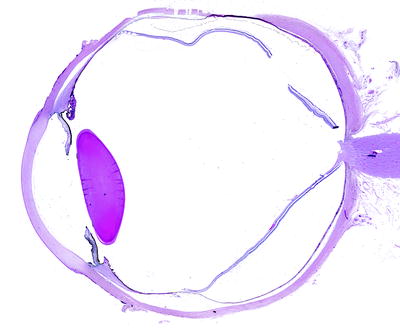
Fig. 1.1
Whole-mount enucleation specimen through the pupil and optic nerve. The pupil is not a histological tissue; its aperture is the space between the leaflets of the iris. The retina shows artifactual detachment typical of almost all sectioned globes. You can tell the detachment is artifact because there is no subretinal eosinophilic fluid
Exenteration: The globe and ocular adnexa are removed (Fig. 1.2).
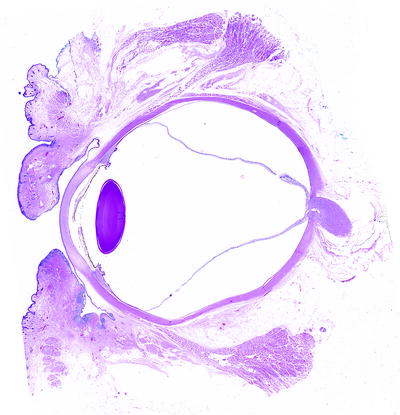
Fig. 1.2
Whole-mount exenteration specimen showing full-thickness eyelid tissue, the globe, and orbital contents including adipose tissue and extraocular muscles
Exenterations are either full or partial, depending on the extent of resection of the eyelids.
Evisceration: The intraocular contents are “scooped out.” The eye is not removed, and the sclera (the white of the eye) is kept intact.
What Are Some Ophthalmology Terms and Abbreviations You Might See on the Surgical Pathology Requisition Form?
AC: anterior chamber (Fig. 1.3)
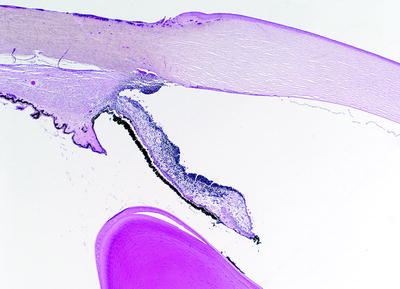
Fig. 1.3
View of the anterior chamber and angle of the eye showing the anatomical relationship between the cornea, conjunctiva, sclera, ciliary body, iris, and lens
AMD: age-related macular dystrophy
Aphakia: absence of the crystalline lens
DALK: deep anterior lamellar keratoplasty
DCR: dacryocystorhinostomy (of the lacrimal drainage system)
DSAEK: Descemet’s stripping automated endothelial keratoplasty
DSEK: Descemet’s stripping endothelial keratoplasty
Epiphora: The drainage of tears down the face rather than through the nasolacrimal duct system
Fellow eye: the unaffected eye (i.e., if a disease process affects one eye only, the unaffected eye is referred to as the fellow eye)
HBID: hereditary benign intraepithelial dyskeratosis
ICE: iridocorneal endothelial syndrome
IOL: intraocular lens
IOP: intraocular pressure
KC or KCN: keratoconus
LASIK: laser in situ keratomileusis
Limbus: the border of the cornea with the sclera and conjunctiva
Madarosis: loss of eye lashes (this is a clue to be alert for the possibility of sebaceous carcinoma)
NLP: no light perception
NVI: neovascularization of iris
OCP: ocular cicatricial pemphigoid
OD: oculus dexter (the right eye)
OS: oculus sinister (the left eye)
OU: oculus uterque (both eyes)
PAS: peripheral anterior synechiae
Phaco (lens): abbreviation for phacoemulsification of the lens (cataract surgery)
Phakia: when the native crystalline lens is present
PK: penetrating keratoplasty, the common surgical procedure for entry into the eye at the limbus
POAG: primary open-angle glaucoma
Pseudophakia: when an artificial intraocular lens is implanted in place of the native lens
RD: retinal detachment
SO: sympathetic ophthalmia
VA: visual acuity
What Are Some Classic Eye Pathology Words (They Also Make Good Spelling Bee Words)?
Calotte:
When a globe is sectioned, the central section is submitted for the pupil – optic nerve section. The calottes are the remaining side pieces. If the globe is sectioned in the horizontal plane, there will be a superior calotte and an inferior calotte. If the globe is sectioned in the vertical plane, there will be a medial calotte and a lateral or temporal calotte. In eyes enucleated for retinoblastoma, the calottes are submitted on edge to evaluate for invasion of the choroid by tumor (see Chap. 6 “Retina”). Calotte “in the shape of a cup or a cap” also refers to a skull cap worn by some students and clergy.
Caruncle:
The caruncle is a conjunctival fold that forms a fleshy elevation in the medial canthal area. The caruncle is lined by nonkeratinizing squamous epithelium and contains sebaceous glands, accessory lacrimal gland tissue, and hair follicles (Fig. 1.4).
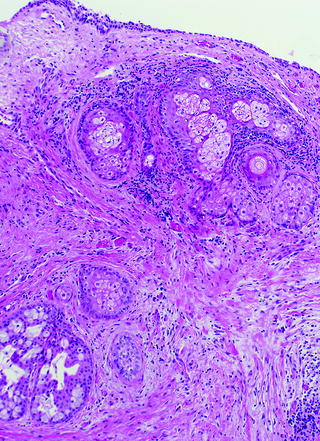
Fig. 1.4
The caruncle is a fold of conjunctiva with adnexal structures, including sebaceous glands and a hair follicle
Chalazion:
A chalazion is a lipogranuloma of the eyelid (Fig. 1.5).

Fig. 1.5
Eyelid chalazion characterized by lipogranulomatous inflammation with lipid droplets within giant cells
Cyclitic membrane:
A cyclitic membrane is a fibrous or fibrovascular membrane that bridges the ciliary body.
Cyclitic membranes are often seen in eyes with a history of trauma.
Neoplastic cyclitic membranes are seen in medulloepithelioma (see Chap. 5 “Uveal Tract”).
Drusen:
Drusen are deposits between the retinal pigment epithelium (RPE) layer and Bruch’s membrane of the choroid. In the macula, they are associated with AMD. Some are large and calcified and can be seen in eyes enucleated for long-standing ocular disease (Fig. 1.6). Calcified drusen also occur at the optic nerve disc.
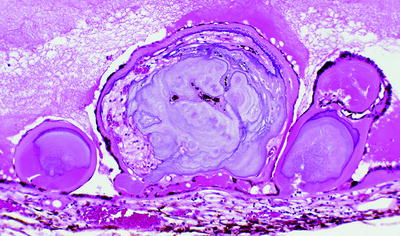
Fig. 1.6
Drusen are concretions thought to arise from the retinal pigmented epithelium (RPE). The choroid is at the bottom of the image
Epidermidalization (of the conjunctiva):
Epidermidalization occurs when the conjunctival epithelium undergoes acanthosis and keratinization and resembles skin.
Guttae:
Guttae are “drops” of membranous material along the posterior aspect of, or buried within, Descemet’s membrane. Guttae are a diagnostic feature of Fuchs’ corneal dystrophy (see Chap. 2 “Cornea”).
Phthisical eye/phthisis bulbi:
Phthisis bulbi refers to a blind, painful, and shrunken eye (Fig. 1.7). Metaplastic ossification arising from the RPE is often present.
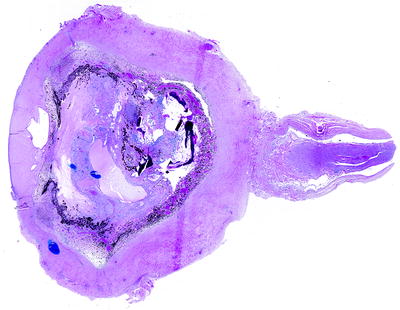
Fig. 1.7
Phthisis bulbi. Whole-mount image of a shrunken and distorted globe with complete disorganization of the inner ocular contents
Pinguecula:
Pingueculae are characterized by actinic elastosis within conjunctival stroma (Fig. 1.8). They are histologically similar to pterygia; however, they do not involve the cornea, and this is what distinguishes them from pterygia.
< div class='tao-gold-member'>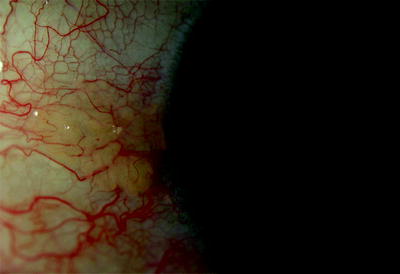 Only gold members can continue reading. Log In or Register to continue
Only gold members can continue reading. Log In or Register to continue
Stay updated, free articles. Join our Telegram channel

Full access? Get Clinical Tree


